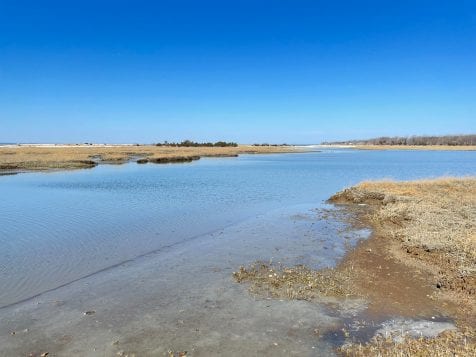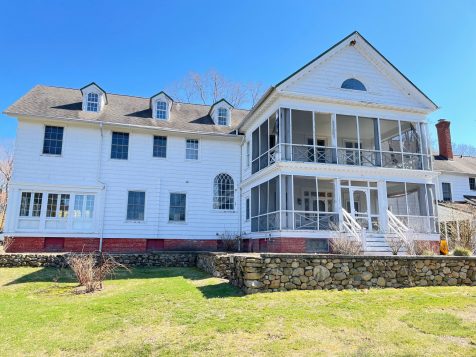Nature Matters: A pond called Flax
By John L. Turner
Scattered along Long Island’s North Shore, in pockets that indent the meandering coastline, are well known places we cherish and enjoy. These harbors and bays like Huntington, Stony Brook, and Mt. Sinai Harbors or Manhasset and Conscience Bays, are places where we fish, kayak, swim, and clam. They are popular places as the number of boats dotting their surface and bathers along their edges can attest. But there is one embayment that has no swimmers, boaters, or clammers — an embayment a bit off the beaten path that has much beauty and is worth exploring — the state-owned Flax Pond in Old Field.
Flax Pond is not a pond now but once was, separated from Long Island Sound by a bermed beach stretching along its northern edge. In the early nineteenth century a section of beach adjacent to the northeastern corner of the pond was scooped away, connecting the Sound’s waters with those of the pond. Flax Pond, so named as it was once a popular place for retting flax, went from being fresh to salt in a matter of days.
You can’t help but notice a building as you pull into the parking lot at Flax Pond. It is the Flax Pond Marine Laboratory operated by the School of Marine and Atmospheric Sciences (SOMAS) at SUNY Stony Brook, in cooperation with the New York State Department of Environmental Conservation which owns the building and the land upon which it sits. SOMAS conducts marine research here on a wide variety of topics including fish and shellfish biology and has a hatchery and algae grow-out center. The lab is used by scientists and graduate students for marine research and is also a destination for students of all ages to learn more about the species and natural communities found in Long Island’s marine environment.
Leaving the parking lot, you’ll pass an informative kiosk that contains an aerial photograph to orient you as well as basic information about the environment at Flax Pond. The easy traversable trail heads west past the Child’s Mansion, where today lectures and seminars are given but where many decades ago Eversley Childs and his family lived. He had bought the house (at that time much smaller and a different style) and several hundred acres which was soon converted into Crane Neck Farm, a working farm, with horse stables, pastures, and gardens. An enormous (by Long Island standards) London Plane tree, a hybrid of our native mottled-bark sycamore tree shades the backyard.
The trail continues through a coastal forest dominated by red cedar, past some artifacts of the outdoor gardens and an orchard that were part of the mansion grounds. Soon the trail forks; stick to the right and in moments will be on a new, elevated boardwalk that traverses the marsh. Shortly, you’ll be greeted with a panoramic view of a salt marsh spilling away on both sides of the boardwalk.
As you near the point where the boardwalk becomes a “bridge,” spanning the tidal creek, look down on both sides in the edge of the marsh mud and if the tide is right (you want to visit at low tide both to see the crabs and to negotiate the trail further north to gain access to the Long Island Sound shoreline) you’ll undoubtedly see many dozens of fiddler crabs. They’ll likely be feeding with both male and female crabs hurriedly stuffing bits of mud into their mouths — the females using both of their arms but the males using only one since the other is an extremely enlarged fiddle that is of no help come dinnertime.
Fiddler crabs are a common and important species in tidal wetland ecology. They recycle plant matter, breaking it down so it may be reincorporated into the salt marsh and are themselves prey items for other species higher up on the food chain like wading birds.
The boardwalk continues, ending on a slightly elevated island. But keep following the highly visible trail markers with the hiking medallions affixed to them as the trail runs along the edge of the coastal forest. Here are the “driftwood skeletons” of many standing but dead red cedar trees, all a silver grey color from years of being burnished in the elements. They are visually stunning.
The trail traverses a low-lying marsh area between the island and the higher ground that separates Flax Pond from Long Island Sound. Please watch for fiddler crabs and their burrows, making sure to not crush any crabs or openings.
If you make it to the beach, you’ll flank a coastal forest dominated by red cedar and post oak. Take a closer look at the oak and you’ll notice its distinctive leaves; thick and leathery, they have rounded lobes telling you they’re a member of the “white oak’ family of oaks and their cross-shape illustrates they are post oaks — no other oak tree species on Long Island has leaves with quite the same outline. The species has an affinity for the coast, and it is along Long Island’s coast, especially the north shore where it is most prevalent.
The wood of the post oak is strong and heavy and is used for making – ready for this? Posts! The wood is also made into railroad ties and tunnel props in mines.
The trail terminates at the shore. In the colder months it’s worth scanning the Sound waters for waterfowl species like scoters, eiders and long-tailed ducks, and for gannets, loons, and horned grebes. In warmer months look for plovers and terns. In all seasons enjoy beachcombing for jingle and slipper shells!
IF YOU GO: To get to Flax Pond take Nicolls Road north to Route 25A in Setauket. Make a left onto Route 25A heading to Stony Brook. Make a right onto Quaker Path Road and veer left onto Mt. Grey Road. Follow Mt. Grey Road past West Meadow Beach Road. Make a left onto Crane Neck Road (look for a stone pillar with a Crane Neck sign on the front). The road winds and passes Holly Lane; shortly after this make a right onto Shore Drive. The Childs Mansion will be on your left; go past it and make a left into the Flax Pond Lab parking lot.
A resident of Setauket, John Turner is conservation chair of the Four Harbors Audubon Society, author of “Exploring the Other Island: A Seasonal Nature Guide to Long Island” and president of Alula Birding & Natural History Tours.

















